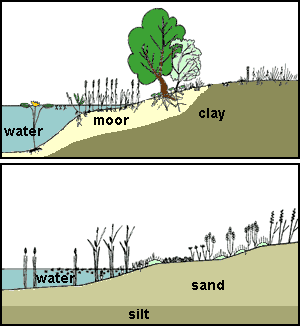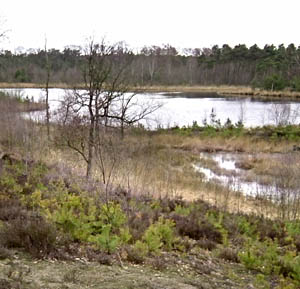Zonation |
|||||||
The most illustrative examples of vegetation zonation are found in locations where environmental conditions vary strongly at a shortdistance. Here below this phenomenon is lined out for coastal and a high mountain vegetation. Zonation, though in a less pronounced way, can be found in the district of Nijmegen along the banks of the Hatertse and Wijchense Fens.
Ath the Northsea coast of the the Netherlands a number of environmental factors can be named that change seen from the coast line along a perpendicular land inwards. Three factors in this profile decrease rapidly at a short distance, namely the salinity, wind velocity and mechanical influence of moving sand particles. One factor that increases is for example the formation of a stable soil. The zonation that arises shows a transition from a band without vegetation to avery open system with only a few plants adapted to extreme conditions, like Sand Couch and See Rocket, to an open grassland dominated by Marram Grass. Behind the first row of dunes the landscape changes to a more closed grassland and brushwood (low shrubs vegetation with Seabuckthorn, Sweet Briar, Dog-rose, Honey Suckle and Wild Privet). More landinward the inner dune wood can be found in which is tall trees occur, like Birch, Aspen, Oak and Sycamore.
Deciduous forest followed by needle trees and (dwarf)bushes vegetation. Above the timber line at about 2200 m dense (close) grasslands (alm meadows) can be found and thereabove open grass land. Even higher, only sparse cushion plants grow, followed by a vegetation of mosses and lichens and finally (nearly) barren rocks. |
|||||||


